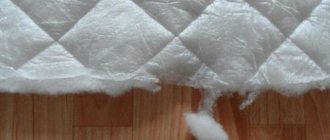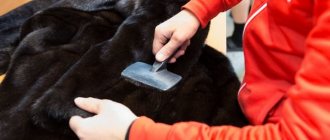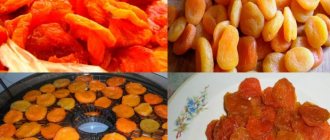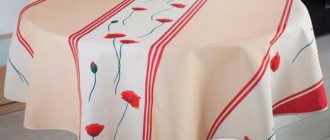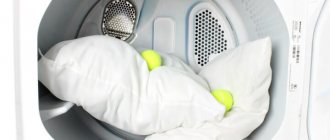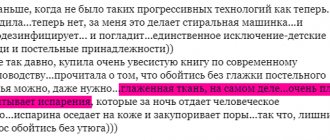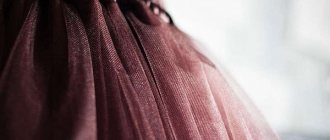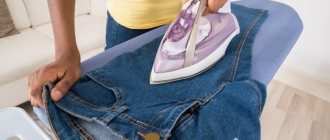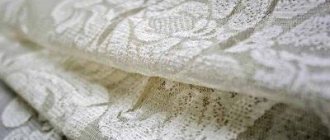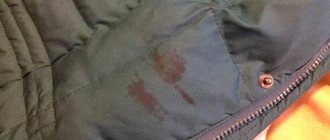When setting a festive table, we very often pre-cover it; for this we use tablecloths. Nowadays, such coverings perform several functions; they make the furniture, the table in particular, tidy, protect it from various damages, and prevent the appearance of stubborn stains. It’s quite convenient to simply remove the tablecloth and wash it, without leaving any traces of fatty food or spilled drinks on the table. Not every housewife can tell you how to wash a polyester tablecloth correctly; the artificial origin of the material requires careful and competent cleaning.
How to wash tablecloths?
Today, not all tablecloths are made of cotton or linen. However, all new tablecloths come with a care label.
For older, unlabeled tablecloths, you can't go wrong with the method of hand washing in cool water or machine washing in cold water on a gentle cycle with minimal spin. Make sure the item is thoroughly rinsed to remove any detergent and never use fabric softener, which may cause discoloration during storage.
It is also important to properly care for specific types of fabrics, including those with beading and fancy trims.
Depending on what material your tablecloth is made of, the type of care for it also depends. The most common options are:
- Natural materials - cotton, linen, bamboo,
- Polyester,
- Blend of synthetic fibers,
- Shtof,
- Lace,
- Brocade,
- Fabrics with trim.
Knitted item
A knitted tablecloth attracts with its openwork patterns, but quickly accumulates dirt. It is impossible to wash a tablecloth-napkin often and it is better to do without the help of a washing machine. Knitting loves hand washing, gentle and neat.
There are a few more rules that will allow the knitted fabric to maintain its original shape and color:
- wash knitting separately from other items;
- do not rub, but soak in a simple soap solution for about half an hour;
- do not heat water above 60 degrees;
- rinse thoroughly;
- do not iron - knitted items turn yellow from the iron, especially if the threads are white.
It is strongly not recommended to wash knitted napkins in a washing machine!
Knitted items do not like automatic machines: the product stretches disproportionately and becomes cloudy. It will have a bad effect on knitting and vertical hanging - it is better to dry the tablecloth directly on the table or other flat horizontal surface.
What to do if the white tablecloth has turned yellow?
If your crisp white tablecloth has turned yellow or gray, follow these steps to correct the situation before ironing and storing the item.
- Mix a solution of warm water and oxygen bleach,
- Immerse the laundry in the solution and let it soak overnight,
- Then wash the tablecloth as usual.
This method is safe to use on cotton, linen and synthetic fibers.
You can also add wash blue and then rinse the tablecloth with water to make the white item look brighter. Simply follow the instructions on the product bottle.
Whitening
Thin jacquard fabric looks like lace. Beautiful tulle is made from it.
Since the service life of products made from jacquard fabrics is long, tulle may turn yellow after several years of service.
How can you bleach this tulle without risking its quality and elegance?
When handling jacquard tulle, you should not resort to products containing chlorine and alcohol-containing substances, otherwise the item may deteriorate and become deformed, and the colors may suffer.
There are old methods that have been used for a long time to bleach delicate fabrics, without the use of chemicals.
For example:
1.Salt solution
Salt is safe for fabric, so washed items are placed in a solution with salt overnight.
- The solution is prepared as follows: add 100 g of salt and 100 g of powder to 8-10 liters of water. The item is kept in the solution for 10-12 hours, then rinsed.
- When rinsing, it is good to add a tablespoon of vinegar to the water for greater whiteness and shine.
2. Solution with baking soda
- 50 g of powder and 1 tablespoon of soda are dissolved in 5 liters of water. The product is kept in the solution for 0.5 hours, after which it is washed again.
3.Use of blue
Blue can be used for both hand and machine washing.
The most important thing when washing by hand is to mix the solution well so that there are no streaks left on the fabric.
In the washing machine, the bluing is placed in the fabric softener compartment - one capful of detergent when washing one curtain.
So where do you start to effectively remove stains?
There are three clues: the location of the stain, its smell, and its color will all give you a starting point and insight into how to remove the stain.
- Location of the stain:
as a rule, stains on tablecloths and napkins remain after eating, and while on napkins they can be literally everywhere, on tablecloths they are present along the outer perimeter of the product. - Odor:
Old oil stains or grease stains may smell somewhat rancid. - Color:
Typically, if the stain is brown, it is protein based and needs to be treated with a protease enzyme cleaner. If the stain is gray in color, it requires the enzyme lipase to be removed.
How hot should the water be?
The nuances of washing are completely determined by the type and color of the fabric from which the tablecloth is made. First of all, the material determines the permissible temperature limit. Most fabrics can be washed up to 40 degrees, but there are some exceptions. In more detail, the list is as follows:
- acrylic washes perfectly when heating water to 30-40 degrees;
- To avoid shedding and fading, colored fabrics are recommended to be washed within 40 degrees;
- for bleaching light-colored products, a temperature of 50-90 degrees is needed;
- cotton does not deteriorate when water is heated to 60 degrees;
- silk is one of the most sensitive materials, it can only be washed delicately and at a maximum of 30-40 degrees;
- For linen fabrics, 40 degrees is enough.
Teflon-impregnated tablecloths can only be cleaned by hand.
Almost all types of tablecloths can survive machine washing without loss. Vinyl, linen, cotton, acrylic and even silk fabrics can be cleaned without any problems in the machine. The only exceptions will be knitted items and Teflon-impregnated fabrics. It is better to refresh them manually and very carefully.
How to remove such stains?
The motto for washing these types of stains is “do no harm,” just like a doctor’s motto.
- Always use the least destructive method to remove the stain. If the fabric is washable, fill the sink with cold water, submerge the item completely, and let it soak for at least 30 minutes to see if the stain fades.
- Then treat the stain with a stain remover in the form of a spray or gel. Apply the stain remover or detergent to the stain by rubbing with your fingers or a soft toothbrush. Leave the product on for at least fifteen minutes and then wash in the manner recommended on the product label.
- Check the stained area before placing the item to dry.
- If the stain remains on the product, it is time to use oxygen bleach. Add it to cold water and soak the fabric. Allow the product to soak for at least four hours or leave the product overnight, then wash it as you normally would.
Drying
Drying jacquard textiles must be done with extreme care.
- Thin or knitted clothing or interior items should be dried on a horizontal surface.
- Since things cannot be wrung out, they are wrapped in a towel or simply blotted with a towel until the water is absorbed into it, and then spread out on a horizontal surface.
- Thin tulle can be dried by hanging the curtain immediately after washing. If the insertion into the drum was carried out correctly, without wrung out, and no creases appeared, then the curtain will smooth out under its own weight, and the need for ironing will disappear.
- Products made of dense fabric are lightly wrung out and hung straight out.
- If drying occurs in the air, then the products should be dried in the shade so that the sun's rays do not fall, and if things are dried indoors, then they should be kept at a distance from heating devices.
- To ensure that the item does not “shrink”, i.e., does not change its size, it is very important to maintain the temperature regime for different washing methods, and wash with delicate detergents.
How to iron tablecloths?
If you chose a wrinkle-resistant fabric for your tablecloth, you can skip most of this section. But even wrinkle-resistant fabrics begin to form wrinkles on their surface if you store the tablecloth by simply stuffing it into a drawer. A few tips for ironing a tablecloth will help you set a beautiful table.
- Before you begin ironing, make sure the soleplate of your iron is clean. If you use a steam iron, test it on an old piece of fabric to make sure no rust has accumulated inside the iron. Otherwise, it may result in brown spots.
- Use a soft ironing board with a smooth, heat-reflective finish.
- The bed linen should be slightly damp, this will make the process easier. Iron a slightly wet tablecloth, and then hang it in the fresh air to dry.
- Start from the wrong side of the garment, gradually moving the ironed parts of the fabric away from the iron. Then repeat the procedure on the front side, without touching the finishing decorative elements, if any.
- Should I starch the tablecloth or napkins? If you want to fold napkins into fancy shapes, you will need to use starch and high heat on your iron to get the desired stiffness. For a softer result, use starch spray and iron on medium heat.
- A tablecloth that has just been ironed should not be folded or stored away. It should be laid out flat and smooth for some time so that it dries completely. When the product is dry, hang it on soft hangers to prevent wrinkles.
Package
For any textile product, packaging is a protective measure while the product makes its way from the store counter to the home of its new owner. Quite often, manufacturers pack tablecloths in a polyethylene cover, which can be easily damaged by any sharp object. As a result, the product can be damaged at any moment. Compared to polyethylene, a cardboard box performs much better protective functions.
Now let's look at our samples. They are sold at almost the same price, but the cotton tablecloth is packaged in PVC, which can only protect against dirt. The polyester jacquard tablecloth we have chosen goes on sale in an aesthetic cardboard box, which protects it not only from dirt, but also from possible damage during transportation.
How to store tablecloths?
Always wash or dry clean tablecloths before storing, and check each item for stains. Some stains may not be visible on the surface, but they can provide food for mold or insects like silverfish. And make sure the tablecloth is completely dry before storing it. Humidity is an excellent breeding ground for mold growth.
Store tablecloths in a cool, dry, well-ventilated area. Wrap it in acid-free tissue paper rather than a regular napkin. The acids in regular paper cloth will cause your tablecloths to turn yellow. Use fabric between the folds to soften the edges, as sharp creases can weaken the fibers of the material.
Never store bedding in plastic bags, cardboard boxes, or in direct contact with wood in furniture. Fumes from polyurethane from plastic boxes and acid from wood can weaken fabrics and give them a yellowish tint.
Acrylic
Advantages:
- Durable.
- The surface does not slip on the table.
- Resistant to solvents.
Care:
- Wash at a temperature of no more than 40 C on a delicate cycle, you can use bleaching agents for white fabrics.
- It almost does not wrinkle and if you hang it carefully, there will be no wrinkles and there will be no need to iron it.
Removing stains: Contaminants on the acrylic surface are removed using a regular sponge soaked in water.
It lends itself well to melting, it is advisable to take this into account if the table decoration is candles, or if one of the guests smokes.
Polyester itself is a synthetic fabric, but it has a number of serious advantages:
- the texture of the fabric is soft and pleasant in the hands, such curtains can even be hung in a child’s room (especially if the composition also contains natural materials);
- the curtains are very durable and wear-resistant, they are suitable for places with a large flow of people - for example, an office or a store. And of course they will serve perfectly in the house.
- polyester drapes well, so it makes luxurious, complex curtains for the living room;
- the fabric does not stretch even after long service;
- they do not harbor small pests - if you decide to change the curtains for a while, you can safely store the fabric and be sure that the curtains will wait in the wings safe and sound.
